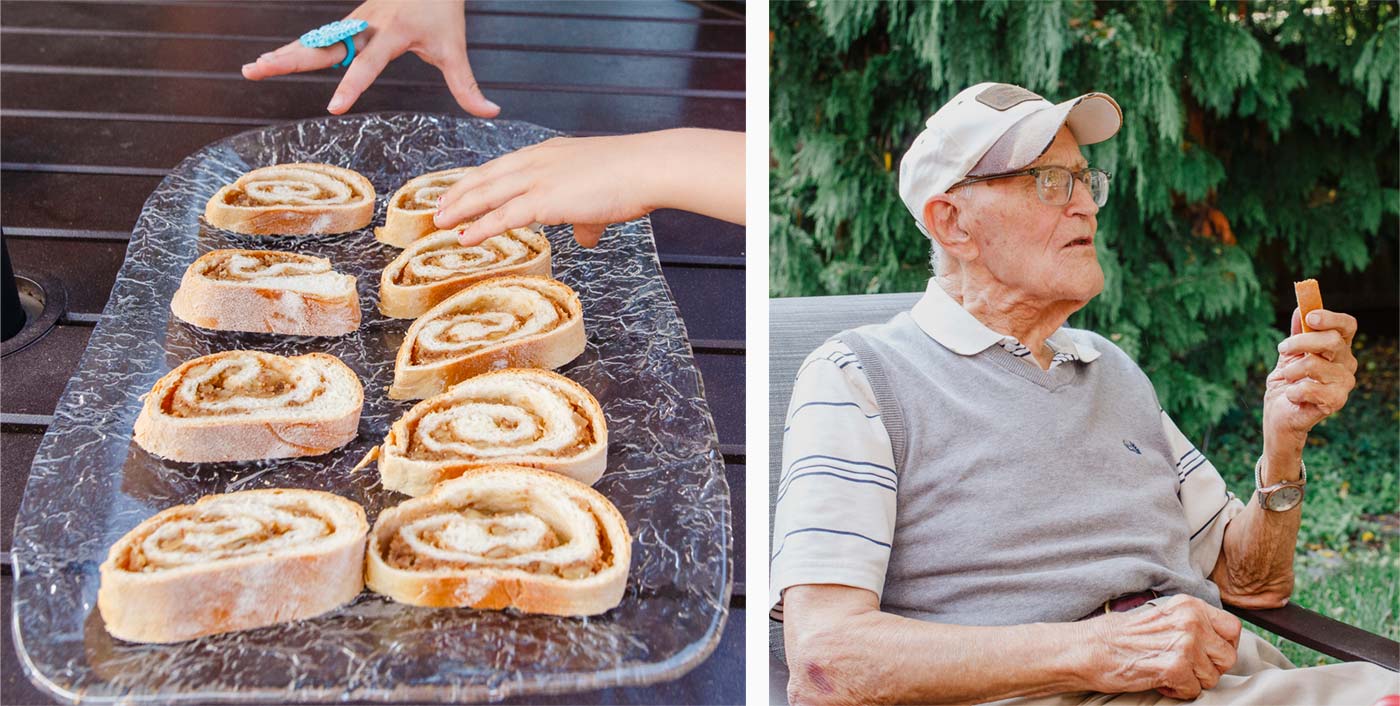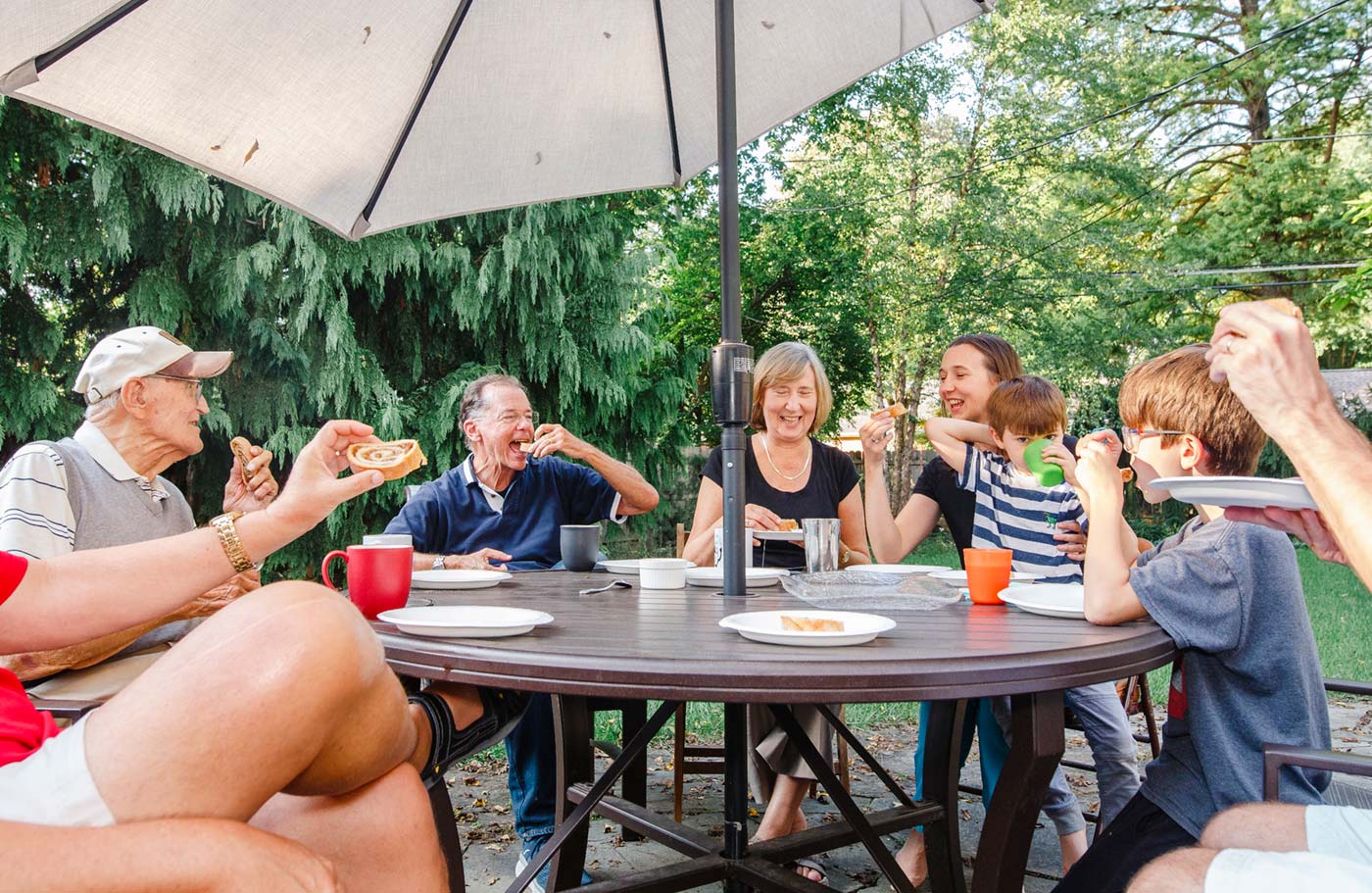Nourishing a Family Tradition
When my grandfather was growing up in Middletown, Ohio, kolache—a Slovak sweet roll—was a sign of the holidays. His mother would bake enough for her seven children, plus friends and neighbors. Without adequate refrigeration or storage, she’d wrap the rolls in linen and store them in a trunk, retrieving one whenever they had company.
My grandpa told me this story a few weeks ago, as he sampled my first attempt at baking kolache. While I hadn’t succeeded in replicating exactly what he’d grown up with—in flavor or scale—I was glad I’d finally tried.
It wasn’t that I hadn’t considered trying before. For years, when the holidays rolled around, I thought about how nice it would be to have some kolache on the table. I even had a recipe, given to me by my mom. It came from her mother, who had jotted it down as she watched her mother-in-law (my great-grandmother) make kolache from memory, documenting every step of the process in hopes of replicating it.
But every time I looked at that recipe, which compresses hours of work onto a single index card and begins with an intimidating 17 cups of flour, I always turned to cookies or something else familiar. Kolache is time-consuming and difficult enough to make that it wasn’t a holiday staple for our family when I was growing up. Some years we had it, most we didn’t. But when we did, I always loved it.
The meaning of the word kolache varies from region to region, family to family, and kitchen to kitchen. In the Czech Republic, it’s a sweet roll encircling an even sweeter filling. Dusty Kotchou, an owner of the Kolache Republic bakery that specializes in this style, said that traditional Czech flavors include poppyseed, apricot and cream cheese.
To my Slovak family, kolache looks—and tastes—quite different. It still starts with sweetened yeasted dough, but this time it’s rolled out flat and wide, like a pie crust, covered almost edge to edge with a walnut or poppyseed filling, and then rolled into a loaf and baked. The result looks like bread on the outside, but slicing it reveals swirls of hidden flavors.
It also seems some specificity may have been lost in translation between Slovakia and Middletown. Kolache, I learned, is often used in Slovak as a generic term for sweets; what we called kolache were more precisely nut and poppyseed rolls known as orechovník and makovník, respectively. (To apply a rule I once learned about squares and rectangles in geometry: Every orechovník is a kolache, but not every kolache is an orechovník).
While the word kolache may mean different things to different people, if you are lucky enough to be one of those people it’s a word—and a food—you won’t forget.

KOLACHE IN COLUMBUS
Though kolache is a popular dessert across Eastern Europe—there are Hungarian and Polish versions as well—if you haven’t tasted it, you probably haven’t heard of it either. Or at least, you probably hadn’t heard of it before Kotchou and his partners opened the Kolache Republic in the Brewery District in 2013.
The kolache at Kolache Republic may be Czech-style, strictly speaking, but its Texas roots and Ohio setting are evident on the menu. (For example, they recently made a seasonal buckeye flavor to celebrate football season.) Over a century ago, while my Slovak great-grandparents were settling in Middletown, many Czech immigrants were arriving in Texas, bringing their kolache with them and turning it into a popular treat. Texas native Rick Jardiolin grew up eating it, and after moving to Ohio found himself craving kolache while drinking beer with Kotchou one night. He described a savory—and very Texas—version: a sweet roll stuffed with jalapeño, cheddar and kielbasa; the perfect late-night food that he couldn’t find on any local menus.
Jardiolin and Kotchu decided to make it themselves. Soon, they were bringing kolache to friends’ houses, to rave reviews. “People said we should do something with it,” Kotchou says. They started selling it at farmers markets until they had the opportunity to open the shop. Today, the Kolache Republic operates in the back of the Daily Growler, ensuring that anyone else craving kolache with their beers won’t have to learn to bake it first.
On the other side of town, at Hilliard’s Center Street Market, Laura Young is doing kolache differently. Her shop, Bakes By Lo, sells cakes, cookies and other sweets throughout the year. But when the holidays roll around, she adds kolache to the menu for a limited time. Young makes the Slovak version, and lists it on her website as her “favorite thing to bake.”
“Kolache reminds me of my childhood, it reminds me of sweet memories in the kitchen with my mom,” she says. In her family, making kolache was a daylong process. As the holidays approached each year, she would gather in the kitchen with her mom and grandma, watching them use a nut grinder to make the filling of walnut and shredded coconut. Young and her family always made enough to freeze and share with friends and relatives. “It lasted all season long.”

(left) The sliced kolache ready to serve; (right) Grandpa proclaims this kolache is “good.”
MY FIRST KOLACHE
At the end of September, my grandfather turned 100. I decided that this was the year I needed (kneaded?) to bake kolache. In celebration of his centennial, I wanted to make the food he had loved as a child. I wanted him to know that it mattered to me, that his great-grandkids will grow up eating it too.
While I loved the idea of using the recipe from the index card my mom had given me, as a novice, starting with 17 cups of flour and ending with 12 rolls was more than I was ready to take on. Luckily, in the many years since my grandmother’s fateful baking observation, the internet had been invented. I found a promising recipe on a blog called Bakes & Blunders. It was similar to but simpler than my mom’s—starting with a manageable three cups of flour and yielding two rolls. It also went into details that could never fit onto an index card, but that I found extremely helpful. Following author Colleen Gershey’s advice, I decided to use a mix of bread and all-purpose flour, and I knew to scald the milk before cooling it and adding yeast, a process that helps the gluten properly form.
And then I had to confront what all seasoned kolache bakers agreed is the biggest challenge: working with yeast. Even though yeast likes warmth, Kotchou explained that humidity can affect yeast dough, and said it’s easier to bake in the cooler months when the air is drier. Young said that she tells her bakers to “be patient” with kolache, reminding them that “working with yeast is hard.” My mom was the most blunt, telling me emphatically, “Don’t kill the yeast!” (It’s no coincidence that one of my childhood kolache memories can be summed up as the day the yeast died. The dough had to be remade from scratch—literally.)
With the dough set to rise in a warmed oven, I started working on the filling. This time, I stuck closely to Mom’s recipe, adding vanilla extract, orange rind and vanilla wafers to the walnuts, but also some cinnamon from Gershey’s version. After the dough came out, I rolled it out, spread on the topping, sealed the loaf with milk and crossed my fingers.
An hour rise and a 45-minute bake later, I had one beauty and one beast. The first roll was picture perfect, but the second had come apart in the oven, the filling bursting through the top. Ugly or not, what mattered was the taste, and that was up to Grandpa to judge. He pronounced my kolache slightly different than what he’d grown up with, but “good.”
That’s all the encouragement I needed to keep going. This may have been my first time making kolache, but it won’t be my last. I’ve already got some tweaks in mind for next time, and like Great-Grandma, I’m not ready to write down my recipe yet—it’s going to evolve, and that’s OK. Because the most important lesson I learned from this process is that the best kolache isn’t the one that’s exactly like Grandma’s; the best kolache is the one that’s yours.

Four generations of the writer's family celebrate the success.
- Kolache Republic is located at 702 S. High St. and on Instagram @kolacherepublic. Bakes By Lo is located at 5354 Center St. in Hilliard, and on Instagram @bakesbylo.





